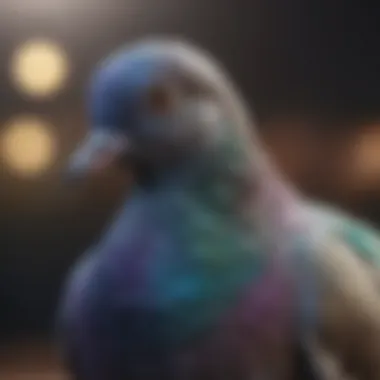Unveiling the Mysterious Lifespan of Pigeons: Factors and Adaptability


Animal Species Profile
Homing pigeons, also known as rock doves (Columba livia), possess a fascinating lifespan that intrigues researchers and bird enthusiasts alike. These avian creatures exhibit remarkable adaptability in various environments, from urban settings to rural landscapes. Sporting a distinctive gray-blue plumage with iridescent markings, homing pigeons are recognized for their elegant appearance and unique flying capabilities. Originating from rocky cliffs and seashores, these birds have successfully colonized urban areas worldwide, showcasing their resilience and versatility as a species. Socially, homing pigeons are highly gregarious, forming close-knit flocks and demonstrating complex communication through vocalizations and body language.
Conservation & Wildlife Efforts
Despite their adaptability, homing pigeons face challenges in urban environments due to habitat loss and exposure to pollutants. Conservation efforts have been limited, given their status as an abundant and widely distributed species. However, organizations such as Pigeon Conservation Society strive to raise awareness about the importance of preserving pigeon populations and their role in urban ecosystems. Success stories in pigeon conservation include initiatives to mitigate pigeon overcrowding in cities, promoting positive coexistence between humans and birds through targeted educational campaigns.
Animal Behavior & Psychology
Homing pigeons exhibit sophisticated communication skills, utilizing cooing sounds and wing gestures to convey messages within their flock. In terms of reproductive behavior, pigeons form monogamous pairs, displaying dedicated parenting traits such as shared incubation and feeding responsibilities. Studies have shown that pigeons possess impressive cognitive abilities, demonstrated through their aptitude for navigation over vast distances and problem-solving tasks. Their social dynamics reveal intricate hierarchies within flocks, emphasizing the significance of emotional intelligence in maintaining group cohesion.
Unique Facts & Trivia
Did you know that pigeons have an exceptional sense of direction that enables them to navigate across unfamiliar territories with precision? These birds also exhibit a quirky behavior known as 'head bobbing,' which serves as a visual signal of excitement or alertness. Pigeons have been known to participate in record-breaking feats, such as speed races covering hundreds of miles in a single day. Additionally, pigeons have shown remarkable adaptability in urban environments, utilizing innovative strategies to thrive amidst human activities.
Pet Care & Tips
For individuals considering pigeons as pets, it is essential to provide sufficient space for flying and perching within their living environment. Basic care requirements include a balanced diet of seeds, grains, and fresh water, along with opportunities for exercise and mental stimulation. Health considerations for pet pigeons involve regular veterinary check-ups to monitor overall well-being and prevent common illnesses. Training techniques focused on positive reinforcement can enhance the bond between pet owners and pigeons, promoting social interaction and mental enrichment.
Introduction
Understanding Pigeons
Pigeons, scientifically known as Columba livia, exhibit fascinating biological characteristics that set them apart in the avian kingdom. Their biology is a testament to their evolutionary success, with features like keen eyesight, strong homing instincts, and exceptional flight capabilities. The importance of understanding the biology of pigeons lies in unraveling the mechanisms that enable these birds to thrive across different habitats and urban landscapes, making them a popular choice for research due to their ubiquitous presence.
The prolific nature of pigeons is another intriguing aspect that warrants exploration. These birds have a remarkable ability to reproduce quickly and adapt to changing environmental conditions. Their high breeding rates and efficient parenting behavior contribute to their widespread distribution and abundance in urban settings. While their prolific nature ensures their survival as a species, it also poses challenges in managing their populations in urban environments, making them a subject of interest for researchers and wildlife enthusiasts alike.
Adaptability to diverse environments is a key survival strategy for pigeons. These birds can thrive in urban, rural, and even remote locations, thanks to their ability to adjust their behavior and food sources accordingly. Their adaptability enables them to forage in diverse landscapes, scavenge for food in urban areas, and roost in a variety of structures. While this adaptability confers an advantage in terms of survival, it also exposes pigeons to human interactions and potential threats present in urban environments.


Significance of Lifespan
The lifespan of pigeons holds significant implications for understanding population dynamics in avian communities. By studying the lifespan of pigeons, researchers can gain valuable insights into the factors influencing population growth, stability, and distribution patterns among these birds. The longevity of pigeons plays a crucial role in shaping their ecological niches and interactions with other species in their environment.
Examining the relationship between lifespan and ecological niches provides essential information about how pigeons adapt to specific habitats and resource availability. Pigeons with longer lifespans may occupy different ecological niches than those with shorter lifespans, influencing their foraging behavior, territoriality, and reproductive success. Understanding this relationship offers a comprehensive view of the intricate balance between lifespan, ecology, and species diversity within avian communities.
Factors Influencing Lifespan
In the realm of avian biology, understanding the factors that influence the lifespan of pigeons is crucial. These avian creatures exhibit a biological complexity that intertwines with both genetic predispositions and environmental influences. Factors influencing lifespan serve as a cornerstone in unraveling the enigmatic longevity observed in pigeon populations. By delving into concepts such as genetics, environmental conditions, and dietary habits, one can grasp the delicate balance that governs a pigeon's lifespan. This section explores the multifaceted nature of these factors, shedding light on their intricate interplay and profound effects on pigeon longevity.
Genetics and Heredity
Influence of genetic makeup on longevity
The genetic makeup of pigeons plays a pivotal role in determining their lifespan. Certain genetic traits can predispose pigeons to enhanced longevity, while others may introduce vulnerabilities that affect their overall well-being. Understanding the influence of genetic factors on longevity is paramount in deciphering the intricacies of pigeon lifespan. Genetic markers associated with longevity can offer insights into evolutionary adaptations that have allowed pigeons to thrive in diverse environments. This section delves into the intricate mechanisms through which genetics shape the lifespan of pigeons, providing a nuanced perspective on the interplay between genes and longevity.
Hereditary traits affecting lifespan
Apart from genetic makeup, hereditary traits passed down through generations can significantly impact the lifespan of pigeons. Traits related to disease resistance, metabolic efficiency, and reproductive success can shape the overall longevity of pigeon populations. Recognizing the hereditary components that influence lifespan sheds light on the adaptive strategies that pigeons have developed over generations. This section elucidates the genetic predispositions that can either bolster or hinder the longevity of pigeons, showcasing the intricate dance between heredity and lifespan.
Environmental Conditions
Impact of habitat quality on pigeon lifespan
The quality of the habitat in which pigeons reside exerts a profound influence on their lifespan. Access to quality nesting sites, availability of food sources, and exposure to natural elements all play a role in determining the longevity of pigeons. Healthy habitats foster behaviors that promote robust health and survival, while degraded environments can challenge the resilience of pigeon populations. Exploring the impact of habitat quality on pigeon lifespan reveals the intricate relationship between environmental conditions and avian longevity.
Effects of pollution and urbanization
In an increasingly urbanized world, pigeons face the dual challenges of pollution and habitat loss due to urban expansion. The effects of pollutants on pigeon health and the disruptions caused by urban development can have far-reaching consequences on their lifespan. Understanding how pollution and urbanization intersect with pigeon habitats is essential in mitigating their detrimental impacts. This section delves into the complexities of navigating urban landscapes for pigeons, highlighting the adaptive strategies they employ in the face of environmental adversity.
Diet and Nutrition


Role of diet in promoting longevity
A well-balanced diet is fundamental in promoting longevity and well-being in pigeons. Optimal nutrition ensures that pigeons receive essential vitamins, minerals, and macronutrients that support their physiological functions. The role of diet in promoting longevity extends beyond mere sustenance, playing a crucial role in enhancing immune function and overall health. This section explores the intricate connection between dietary choices and pigeon lifespan, emphasizing the importance of nutrition in sustaining robust avian populations.
Nutritional requirements for healthy pigeons
Meeting the nutritional requirements of pigeons is key to maintaining their health and vitality. Specific dietary needs, such as protein sources, calcium supplements, and hydration levels, must be meticulously managed to support the longevity of pigeons. Understanding the nuanced nutritional requirements of pigeons sheds light on the intricacies of avian dietary habits and their impact on lifespan. This section delves into the essential nutrients that contribute to pigeon well-being, offering insights into best practices for ensuring the health and longevity of these remarkable avian creatures.
Typical Lifespan
In the realm of avian biology, the discourse on the lifespan of pigeons holds a crucial position. The typical lifespan of pigeons serves as a fundamental metric in understanding avian longevity and survival strategies. Exploring the complexity of factors that influence the lifespan of these birds provides invaluable insights into their resilience and adaptability in various environments. By delving into the average lifespan of pigeons, we unravel a tapestry of evolutionary selection pressures, environmental adaptations, and genetic predispositions that define the longevity of these avian creatures. Understanding the typical lifespan of pigeons not only enriches our knowledge of avian biology but also offers a window into the intricate mechanisms that govern survival in the avian world.
Average Lifespan of Pigeons
Comparative analysis of wild vs. domestic pigeons
The comparative analysis of wild and domestic pigeons unveils fascinating contrasts in their lifespans, each shaped by distinct contexts and evolutionary trajectories. Wild pigeons, thriving in natural habitats, showcase a robust resilience to environmental challenges and predators, contributing to a comparatively longer lifespan. In contrast, domestic pigeons, bred by humans for specific traits, often exhibit variations in lifespan influenced by artificial selection and controlled breeding environments. The juxtaposition of these two pigeon populations offers a unique lens into the impact of human intervention on avian longevity and the interplay between natural selection and artificial breeding practices driving lifespan diversity among pigeons.
Factors contributing to differences in lifespan
Diverse factors intricately weave the fabric of pigeon lifespan disparities, ranging from genetic predispositions to environmental influences. Genetic diversity, varying between wild and domestic pigeon populations, plays a pivotal role in shaping individual longevity by modulating susceptibility to diseases and environmental stressors. Additionally, environmental conditions such as habitat quality, food availability, and exposure to pollutants significantly impact the health and longevity of pigeons. By dissecting the multifaceted influences of genetics and environmental factors on pigeon lifespan, we gain a deeper appreciation for the complex interplay of nature and nurture in shaping avian longevity.
Longevity in Captivity
Impact of care and environment on captive pigeons
The longevity of pigeons in captivity is intricately tied to the quality of care and environmental stimuli provided within captive settings. Pigeons reared in enriched environments with proper nutrition, social interactions, and mental stimulation exhibit enhanced wellness and prolonged lifespans. Conversely, neglectful care, inadequate nutrition, and stressful conditions can detrimentally impact the health and longevity of captive pigeons. Understanding the profound influence of captive care practices and environmental enrichment on pigeon longevity highlights the ethical responsibilities involved in nurturing avian well-being in captivity.
Promoting healthy aging in captive settings


Promoting healthy aging in captive pigeons necessitates a holistic approach encompassing balanced nutrition, veterinary care, environmental enrichment, and mental stimulation. By prioritizing preventive healthcare measures, regular monitoring, and environmental modifications conducive to natural behaviors, we can support the physical and mental well-being of captive pigeons as they age. Incorporating proactive health promotion strategies tailored to the individual needs of captive pigeons fosters a culture of compassion and stewardship towards avian companions, enriching their quality of life and promoting longevity in captivity.
Challenges to Lifespan
Challenges to longevity play a vital role in understanding the overall lifespan of pigeons. In this section, we delve into the specific elements that pose threats to the longevity of these avian creatures. By focusing on the challenges they face from both natural predators and human-induced risks, we gain valuable insights into the complexities of pigeon survival. Understanding these challenges not only sheds light on the fragility of pigeon populations but also emphasizes the importance of conservation efforts to mitigate these threats.
Predation and Threats
Natural misstyp.repators of PogieMis
Pigeons face a multitude of natural predators in their environments, ranging from birds of prey to mammals. These predators play a significant role in shaping pigeon populations and their longevity. The key characteristic of natural predators is their innate hunting instincts, specifically targeting pigeons as a food source. Despite the challenges they pose, natural predators also contribute to the natural balance of ecosystems by controlling pigeon populations. However, this predatory pressure underscores the constant struggle for survival that pigeons must navigate in the wild.
Human-induced risks to pegan pebsolieties
Human-induced risks present another set of challenges for pigeon populations. From habitat destruction to pollution, human activities have a direct impact on pigeon survival. These risks are beneficial to discuss in this article as they highlight the complex relationship between human actions and wildlife. The unique feature of human-induced risks is their anthropogenic origins, posing different threats than natural predators. While these risks can be detrimental to pigeon populations, they also serve as a call to action for sustainable practices and conservation efforts to safeguard these avian species.
Disease and Health Issues
Common health problwrms affectin pieots
Pigeons are susceptible to various health issues, including respiratory infections and parasites. These common problems significantly influence the wellbeing and longevity of pigeon populations. The key characteristic of these health issues is their prevalence in both wild and captive pigeons, illustrating the widespread impact on avian health. While these health problems can be concerning, they also serve as indicators of environmental factors affecting pigeon lifespans.
Preventive measures for pisease manaso
Implementing preventive measures is crucial for managing disease outbreaks in pigeon populations. By adopting strategies such as regular health checks and hygiene practices, pigeon enthusiasts can mitigate the risks associated with common health issues. The key characteristic of preventive measures is their proactive approach to maintaining pigeon health, emphasizing preventive care over reactive treatments. These measures not only benefit individual pigeons but also contribute to the overall resilience of pigeon populations against disease threats.
Conclusion
Insights into Pigeon Lifespan
Summary of key factors influencing pigeon longevity
Exploring the Summary of key factors influencing pigeon longevity sheds light on the crucial elements that dictate the lifespan of these avian creatures. This subheading delves into the genetic, environmental, and dietary aspects that play a role in pigeon longevity. Understanding these factors not only enriches our comprehension of pigeon biology but also provides a framework for future research. The nuanced discussions around genetic predispositions and habitat influences underscore the complexity of avian ecology, painting a vivid picture of the delicate balance that determines lifespan.
Implications for future research and conservation efforts
Turning towards the Implications for future research and conservation efforts, we step into the realm of practical applications and the broader implications of studying pigeon lifespan. This subsection illuminates the pathways for future inquiries and emphasizes the importance of conservation efforts. By highlighting the urgency of preserving pigeon populations and the ecosystem they inhabit, this segment underscores the interconnectedness of research, conservation, and ecological sustainability. The discussion underscores the critical need for long-term monitoring and strategic interventions to safeguard the diverse habitats where pigeons thrive, reflecting a forward-looking approach to wildlife management and biodiversity preservation.







